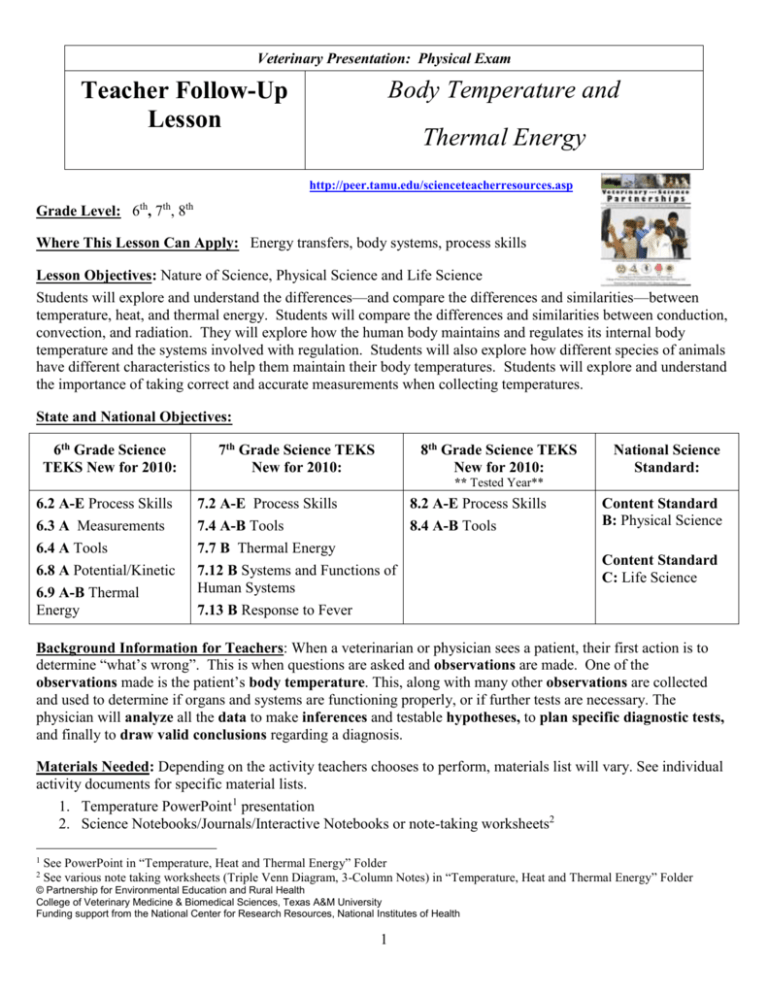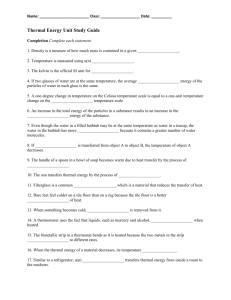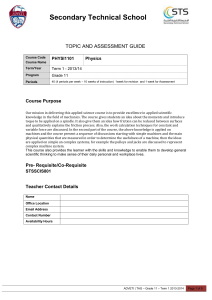Grade Level: 7th and 8th - PEER
advertisement

Veterinary Presentation: Physical Exam Body Temperature and Teacher Follow-Up Lesson Thermal Energy http://peer.tamu.edu/scienceteacherresources.asp Grade Level: 6th, 7th, 8th Where This Lesson Can Apply: Energy transfers, body systems, process skills Lesson Objectives: Nature of Science, Physical Science and Life Science Students will explore and understand the differences—and compare the differences and similarities—between temperature, heat, and thermal energy. Students will compare the differences and similarities between conduction, convection, and radiation. They will explore how the human body maintains and regulates its internal body temperature and the systems involved with regulation. Students will also explore how different species of animals have different characteristics to help them maintain their body temperatures. Students will explore and understand the importance of taking correct and accurate measurements when collecting temperatures. State and National Objectives: 6th Grade Science TEKS New for 2010: 7th Grade Science TEKS New for 2010: 8th Grade Science TEKS New for 2010: National Science Standard: ** Tested Year** 6.2 A-E Process Skills 6.3 A Measurements 6.4 A Tools 6.8 A Potential/Kinetic 6.9 A-B Thermal Energy 7.2 A-E Process Skills 8.2 A-E Process Skills 7.4 A-B Tools 8.4 A-B Tools 7.7 B Thermal Energy 7.12 B Systems and Functions of Human Systems 7.13 B Response to Fever Content Standard B: Physical Science Content Standard C: Life Science Background Information for Teachers: When a veterinarian or physician sees a patient, their first action is to determine “what’s wrong”. This is when questions are asked and observations are made. One of the observations made is the patient’s body temperature. This, along with many other observations are collected and used to determine if organs and systems are functioning properly, or if further tests are necessary. The physician will analyze all the data to make inferences and testable hypotheses, to plan specific diagnostic tests, and finally to draw valid conclusions regarding a diagnosis. Materials Needed: Depending on the activity teachers chooses to perform, materials list will vary. See individual activity documents for specific material lists. 1. Temperature PowerPoint1 presentation 2. Science Notebooks/Journals/Interactive Notebooks or note-taking worksheets2 1 2 See PowerPoint in “Temperature, Heat and Thermal Energy” Folder See various note taking worksheets (Triple Venn Diagram, 3-Column Notes) in “Temperature, Heat and Thermal Energy” Folder © Partnership for Environmental Education and Rural Health College of Veterinary Medicine & Biomedical Sciences, Texas A&M University Funding support from the National Center for Research Resources, National Institutes of Health 1 Veterinarian Presentation: Physical Exam Body Temperature and Thermal Energy Lesson Plan Prerequisite to Lesson: Veterinary Presentation3 and Background Information Lesson Procedures: Based on 5E Model4 – Engage, Explore, Explain, Elaborate, Evaluate Engage Step: Veterinary presentation, video link to presentation, or teacher’s review of presentation with class—this lesson is designed to capitalize on students’ natural interest in animals to help motivate them to learn the required science curriculum. Engage Evaluate Explore 5 E’s Lesson Plan Explore Step: (1/2 to 1 class period): Choose one or more of the activities available in this lesson and follow the listed procedures. (You also could set up activity stations for students to move through several activities in rotation.) Upon completion of each activity, students are to answer questions or complete assigned worksheet. Follow up Elaborate each activity with class discussions about data collected, results, and overall conclusions. The activities to choose from are: How to Make a Thermometer Activity Food Coloring and Different Water Temperatures Activity (Have students graph results!!) Conductor vs. Insulator Activity Microwave and Soap Activity (representing convection) Radiation Activity Body Temperature Activity Explain Explain Step, Option One (1 class period): Spend time going through Temperature PowerPoint, explaining concepts being taught. Teachers are encouraged to stop periodically throughout the PowerPoint to refer back to the activities in the “Explore Step” and the concepts they stressed and to discuss questions on slides, before presenting the slide with answers. Students can work in pairs when answering questions. Students can use 3-column note strategy to keep concepts such as temperature, heat, and thermal energy clear in their notes. (This can also be used for concepts such as conduction, convection, and radiation.) Teacher can then use Triple Venn Diagrams5 to compare/contrast temperature, heat, and thermal energy as well as conduction, convection, and radiation. Explain Step, Option Two (1/2 class period)6: Assign students the Comic Strip Activity7 as an in-class assignment or as a homework assignment, applying what they learned during the Power Point presentation. This activity entails students filling in the words for the pictures they see or vice versa (drawing pictures for the description given) all in a comic strip format. Some students may choose to create their own drawings and descriptions completely. Teachers can vary comic strip activity to fit level and creativity of their students. Be sure to allow students to share their comic strips with class. Grade according to how you assigned it. Explain Step, Option Three (1/2 class period)8: Based on when and where the teacher includes the Make Your Own Thermometer Activity9, include the following steps: 3 Veterinarian visit is useful—but not mandatory—for lesson to be taught See 5E Model link under “Resources for Teachers” at end of lesson plan 5 See Triple Venn Diagram worksheet in “Temperature, Heat and Thermal Energy” Folder 6 Feel free to assign these activities to groups or individually. Your class size and time constraints will dictate this. 7 See Comic Strip Activity Worksheet in “Temperature, Heat and Thermal Energy” Folder 8 Feel free to assign these activities to groups or individually. Your class size and time constraints will dictate this. 9 See Make Your Own Thermometer document in “Temperature, Heat and Thermal Energy” Folder 4 © Partnership for Environmental Education and Rural Health College of Veterinary Medicine & Biomedical Sciences, Texas A&M University Funding support from the National Center for Research Resources, National Institutes of Health 2 Veterinarian Presentation: Physical Exam Body Temperature and Thermal Energy Lesson Plan Have students hypothesize about how accurate their thermometer will be compared to others. Observation and data collection: Have students use their thermometer to take the temperature of various containers holding various water at various temperatures; they may also use them to take the temperatures of the various products used in the Radiation Activity.. Analyze Results: Have students compare their homemade thermometer readings to a regular bulb thermometer, a digital thermometer, and then to the accuracy of temperature probes, if your school has them. Have students summarize their results and draw conclusions about the accuracy of their readings with the various thermometers. Which worked best? How far off was the homemade one, if at all? Have students look up the history of thermometer. When was the first thermometer invented and by whom? How does a thermometer work? (What is the physics behind it?) Advancements in thermometer development: Are they becoming even more accurate? How? Elaborate Step: After students have gathered all authentic information necessary from PowerPoint and class discussion, the teacher can assign the Body Temperature Activity10. This can be assigned over a weekend and turned in as a major project grade or as an alternative assessment grade. This activity addresses homeostasis, equilibrium, negative feedback, and the interaction of systems. Students should be sure to reference the body systems involved and the negative feedback mechanisms at work to maintain stable internal temperatures. Students can share results with class, discussing whether they were sick or healthy at time of data collection and at what points they were most active. Variation on Body Temperature Activity: Students could take the temperatures of and collect observation data on another member of their household. This perspective places the student in the observant scientist mode, and they can experience science through inquiry and address all their necessary process skills and steps to the scientific method: o Problem (Temperature and Activity Levels) o Background Info o Hypothesis (when will person be most active) o Tests/Data Collection o Analyze Data o Draw a Conclusion o Share Results Supplemental Elaborate Step: Have students research and add information on warm-blooded organisms vs. coldblooded organisms. Students can compare the activity levels, times of activity, and temperatures of warm-blooded animals and cold-blooded animals. Further (optional) Elaborate Steps: Have students create their own data tables—using data from the activity with the food coloring and the different water temperatures—showing the temperature and time variables. Table Example: 10 See Body Temperature document in “Temperature, Heat and Thermal Energy” Folder in Physical Exam Module © Partnership for Environmental Education and Rural Health College of Veterinary Medicine & Biomedical Sciences, Texas A&M University Funding support from the National Center for Research Resources, National Institutes of Health 3 Veterinarian Presentation: Physical Exam Body Temperature and Thermal Energy Lesson Plan Evaluate Step: Evaluate student products for understanding of concepts taught. Vocabulary: Definitions for the following words can be found in the accompanying PowerPoint presentation: heat, temperature, thermal energy, conduction, convection, radiation, boiling point, melting point, absolute zero, homeostasis, equilibrium, chemical reaction, thermoregulation, warm blooded, cold blooded, Brownian motion, potential energy, kinetic energy, negative feedback mechanisms Resources for Teachers: 5 E model site and other lesson plan formats: http://www.personal.psu.edu/scs15/idweb/lessonplanning.htm Gallery Walk Strategy: http://www.udel.edu/dssep/teaching_strategies/gallerywalk.htm o Give One-Get One Strategy: In this strategy, you split up the questions amongst the students in class; after students find the answer to their question, they go around the room getting the answer to another question from a different student while at the same time giving that student an answer to another question. You do this until everyone has all their boxes of questions answered. For an appropriate worksheet, please see “Give One–Get One Worksheet” file in Temperature folder. Web MD: http://firstaid.webmd.com/body-temperature Homeostasis – Negative feedback: http://science.jrank.org/pages/3365/Homeostasis.html Rhythms Activities: http://faculty.washington.edu/chudler/clock.html Experiments on Body Systems Page: http://faculty.washington.edu/chudler/experi.html Temperature and Absolute Zero Interactive: http://faculty.washington.edu/chudler/experi.html Cool Cosmos - Temperature: http://coolcosmos.ipac.caltech.edu/cosmic_classroom/light_lessons/thermal/measure.html Graphic Organizers: http://freeology.com/graphicorgs/page2.php Heat Transfer and Radiation Activity- http://www.ucar.edu/learn/1_1_2_5t.htm © Partnership for Environmental Education and Rural Health College of Veterinary Medicine & Biomedical Sciences, Texas A&M University Funding support from the National Center for Research Resources, National Institutes of Health 4









